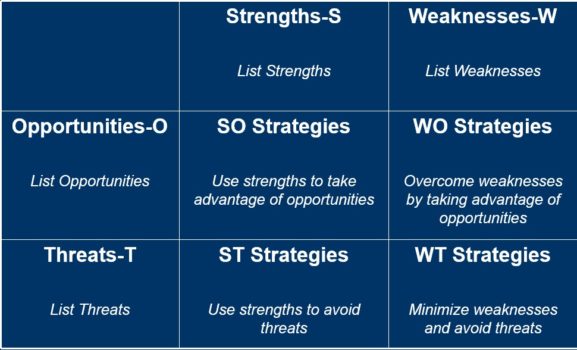An entrepreneur does everything possible to make his company profitable. Strategies are the ones that can be the game-changer. Opening a startup or a company is way easier than making it successful and profitable. There is a very thin line between success and failure and strategies may play a critical role. Tows matrix is one of the strategies adopted by companies to become successful in all aspects.
Table of Contents
What is TOWS Matrix?
TOWS’ full form is Threats, Opportunities, Weakness, and Strengths.
T – Threats means the danger that may pose a fear of failure. Uncertainty and an unknown future open up room for fear, anxiety, as nothing can be predicted with 100% accuracy.
Companies suffer threats from the external environment, below are some of them:
- Threat from established competitors who are in the business for years.
- Fear of getting the product or service offered copied easily.
- Fear of no customer demand for the products or services offered.
- Uncertain environment, the very case of covid-19 which was unpredictable. It wiped off a lot of small businesses.
- Seasonal fluctuations due to demand and supply mismatch.
- Changing technology and innovations in the market.
- Changed Government rules and regulations or policies.
O – Opportunities are possibilities yet to be explored. Past track records, innovations, customer demands open up room for opportunities. These opportunities are mostly related to the external environment.
Below are some of the opportunities that companies must explore to restructure their business in order to increase profit margins:
- New customer demand or requirements which are not currently met by the existing players in the market.
- Finding a solution to the existing problems.
- Offering better products and services with enhanced features.
- Expanding the business both online and offline.
- Horizontal or vertical integration.
- Acquisitions and mergers.
W – Weakness means a flaw that may affect the companies adversely. Any weakness or flaw is internal to the company, and accepting those flaws while working to minimize them is the best strategy.
The company needs to identify weaknesses internally and below are some of them:
- Wastages due to inadequate use of available resources.
- More unproductive hours and excess manpower.
- The manual workload is repetitive in nature and ongoing.
- Raw material shortage due to high dependence on external vendors.
- Quality issues, where products or services offered are not standardized.
S – Strengths mean the key advantage or the x-factor that the company has. Every company has a core strength that is unique and has a competitive advantage. Strengths refer to the benefit that is inherent to any company.
Companies may have below strengths internally:
- A company offering a unique value proposition product or service to the customers.
- A company having experienced management with experienced employees.
- The company is backed up by the Parent company.
- Funding received by the company.
- A company having a domestic as well as a global presence.
All the above threats, opportunities, weaknesses, and strengths are interrelated and interdependent. The company has to identify all, through tows matrix analysis and then use tows strategy management to ensure strategy formulations and risk minimization.

TOWS Matrix Strategies:
TOWS matrix is very well used for formulating successful strategies for any company. TOWS matrix strategies are very popular.
There are 4 types of TOWS matrix strategies:
- SO Strategy
This is known as Strength Opportunities Strategy. This focuses on using a firm’s internal strengths to take advantage of external opportunities. Identify the internal strengths of a firm and used them to explore an opportunity that already exists.
- WO Strategy
Known as Weakness Opportunities Strategy. This will help the company to improve internal weaknesses by taking advantage of external opportunities.
- ST Strategy
It is known as the Strengths Threats Strategy. This involves using the firm’s strengths to avoid or reduce the impact of external threats. Risk minimization is the result of using this strategy effectively.
- WT Strategy
It is called Weakness Strengths Strategy. It involves defensive tactics aimed at reducing internal weaknesses and avoiding environmental threats.
TOWS Matrix Example:
Below are the TOWS matrix examples as to how to use the Tows matrix to formulate effective strategies which will help in strategic management, risk management, profit maximization, and expansion of any company:
- SO Strategy
Strength- A company that deals in cell phones have excess working capacity because of a huge number of manpower and resources which is a Strength for that company.
Opportunity – there is a 20% annual growth in the cell phone market as of this year.
Strategy – Acquire a subsidiary that manufactures cell phones but has limited supply due to which it is slowly gaining market. This way the company can utilize its excess capacity while expanding its market through this subsidiary.
- WO Strategy
Weakness – A company has insufficient capacity.
Opportunity – Competitors have exited the market because of internal issues.
Strategy – Pursue horizontal integration by buying competitors’ facilities.
- ST Strategy
Strength – Strong research and development team in the company with experienced team members.
Threat – Changing technologies, customer demands, and requirements.
Strategy – Develop innovative products and services with advanced features to solve customers’ problems and ensure customer delight.
- WT Strategy
Weakness – The morale of the employees f the company is very low.
Threat – Strong employee union formation in the industrial area where the company is located.
Strategy – Develop a new employee benefits policy and provide better work-life balance to the employees. Introduce employee rewards and recognition programs and link productivity with incentive plans.
Above are 4 types of TOWS matrix strategy also known as SWOT TOWS analysis. The strategies so formed are effective and help the companies to restructure to reach achievable objectives both short term and long term.

Difference between SWOT and TOWS?
SWOT Matrix and TOWS matrix broadly are strategic management approaches. However, both are not one and the same, however, the end result of both is aimed towards forming effective strategies for a company to increase its profitability, minimize risk while increasing revenue. Below are the basic differences between SWOT and TOWS matrix.
|
SWOT Matrix |
TOWS Matrix |
|
Strength, Weakness, Opportunity, Threat |
Threat, Opportunity, Weakness, Strength |
|
Internal to the external approach |
External to Internal approach |
|
Focuses on the current situation |
Focuses on futuristic situations |
|
No strategy formation takes place |
Strategy formation takes place |
Benefits of using TOWS Matrix?
TOWS matrix is helpful in restructuring the company’s policies. It helps set the right strategies for the long run to achieve respective goals. Below are some of the TOWS matrix benefits received by the company:
- Knowing real self
TOWS matrix helps the company to take out time to introspect and identify internal strengths and weaknesses. Further threats and opportunities are also identified. The company should be informed about its own itself before trying to strategize better. Knowing real self and real worth is the first step which is easily achieved by the TOWS matrix.
- Strategy formulation
TOWS matrix is great in setting the foundation of strategies based on TOWS analysis. Each strength, weakness, opportunity, and threat will be matched one by one to form a respective strategy. These strategies are vital to improve the company’s overall performance and achieve its respective objectives.
- Preventive measure
Prevention is better than cure. This rightly applies to companies using the TOWS matrix. It helps the companies to prepare for the worst. While being ready to grab any opportunity available. If a company does face an unforeseen situation, it is well equipped to handle the unwanted shocks without losing financial stability.
- Cost control
Improving profit margins, increasing revenue is the result of controlling costs. TOWS matrix helps companies to convert their weaknesses into opportunities to make the best out of them. Reducing wastages, optimum utilization of resources, automation, simplification helps in cost reduction.
Thus, TOWS matrix analysis resembles that of SWOT analysis but the TOWS matrix is more effective and futuristic in approach. In fact, SWOT TOWS analysis combining will reap maximum benefits for any company.
Example of Verizon Swot Analysis
A SWOT analysis is a strategic planning tool that helps organizations identify their internal strengths and weaknesses, as well as external opportunities and threats.
Strengths:
- Market Leadership: Verizon is one of the largest telecommunications companies in the world, holding a significant market share in the United States. It is a leader in providing wireless and broadband services.
- Strong Brand Recognition: Verizon has a strong brand that is associated with reliability and quality service. This brand strength can attract and retain customers in a competitive market.
- Advanced Network Infrastructure: Verizon has invested heavily in building and maintaining a robust network infrastructure, particularly in terms of 4G LTE and 5G technologies. This positions the company to offer high-speed, reliable connectivity.
- Diverse Service Portfolio: Verizon offers a wide range of telecommunications services, including wireless, broadband, television, and enterprise solutions. This diversification helps the company mitigate risks associated with dependence on a single market segment.
- Innovation and Technology: Verizon has been at the forefront of technology adoption, especially in the realm of 5G. Its commitment to innovation enables it to offer cutting-edge services and stay ahead of competitors.
Weaknesses:
- High Capital Expenditure: The development and maintenance of advanced network infrastructure, especially in the 5G era, require substantial capital investment. This can strain the company’s financial resources.
- Regulatory Challenges: The telecommunications industry is subject to various regulations, and changes in regulatory environments can impact Verizon’s operations. Compliance with these regulations may pose challenges.
- Dependence on the U.S. Market: While Verizon has a significant presence in the United States, its dependence on this market makes it vulnerable to economic downturns and regulatory changes specific to the U.S.
- Customer Service Concerns: Like many telecommunications companies, Verizon has faced criticism for customer service issues. Improving customer service and addressing consumer complaints are ongoing challenges.
Opportunities:
- 5G Expansion: The rollout and expansion of 5G networks provide opportunities for Verizon to offer new and enhanced services, catering to the growing demand for high-speed, low-latency connectivity.
- Internet of Things (IoT): The increasing adoption of IoT devices presents an opportunity for Verizon to provide connectivity solutions for smart homes, cities, and industries.
- Strategic Partnerships: Collaborations with technology companies, content providers, and other stakeholders can open up new avenues for growth and innovation.
- International Expansion: Exploring and expanding into international markets can diversify Verizon’s revenue streams and reduce dependence on the U.S. market.
Threats:
- Competition: The telecommunications industry is highly competitive, with numerous players vying for market share. Intense competition can lead to price wars and reduced profit margins.
- Technological Disruption: Rapid technological advancements may pose a threat if Verizon fails to keep pace with changes. Disruptions such as new communication technologies or alternative service delivery models could impact the company’s market position.
- Cybersecurity Risks: As a provider of telecommunications services, Verizon faces cybersecurity threats that could compromise customer data and erode trust. The increasing sophistication of cyber attacks is a significant concern.
- Economic Downturn: Economic uncertainties and downturns can impact consumer spending, leading to reduced demand for non-essential services like premium telecommunications offerings.
This SWOT analysis provides a snapshot of Verizon’s internal and external factors influencing its strategic position. It’s important for the company to regularly reassess these factors and adjust its strategies accordingly to stay competitive in the dynamic telecommunications industry.
FunFact:
Using SWOT TOWS matrix analysis around 20% of the startups have survived the covid-19 pandemic and are still surviving.
Your thoughts on TOWS matrix analysis?

